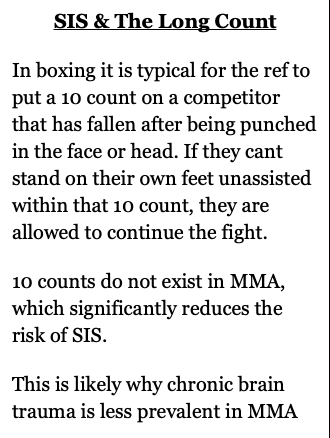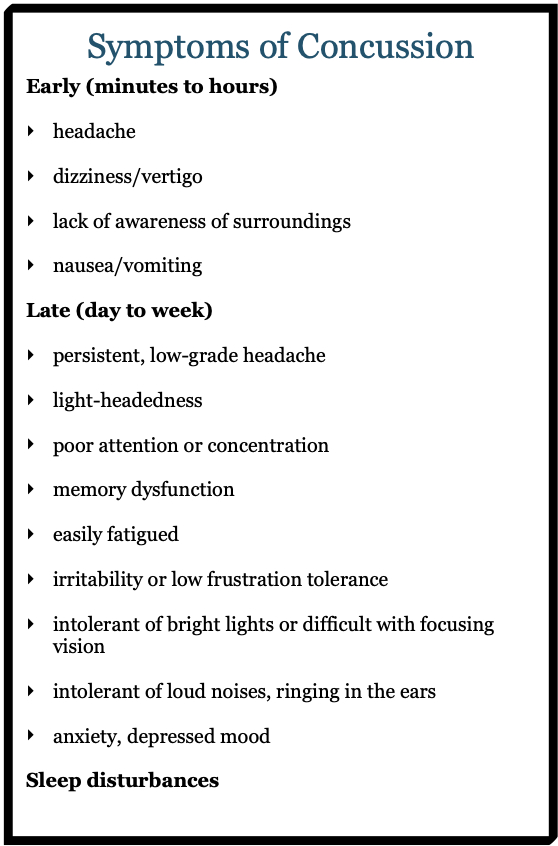
Factors influencing the severity of the injury include undisclosed/ignored injuries from past competitions; second impact syndrome (two successive blows to the head that can result in life threatening swelling); poor medical history intake (diabetes, blood and heart disorders); cerebral abnormalities (aneurysm, arteriovenous malformation, angiomas, arachnoid cysts, contusions, subdural hematoma); weight loss/dehydration (severe dehydration can result in death); age (older fighters bodies have a more difficult time recovering from injury or illness); medication (blood thinners can increase the risk of hemorrhaging); alcohol/PEDS (stimulants can be cytotoxic); inadequate rest (potential for overtraining, not allowing the body appropriate time to heal). Not fully disclosing prior concussions to your medical provider can result in serious consequences, especially if there was not adequate enough time to recover. Second impact syndrome occurs when the brain has not recovered from swelling due to head trauma, and a second blow is sustained. Even if the second strike is minor, this can result in death. Some cerebral abnormalities can be screened by an MRI and properly treated or advice will be given to the fighter for how to adjust their career accordingly. Medications such as aspirin can limit the clotting of blood, leading to hemorrhaging if a brain bleed occurs.

Prevention: It is important to note that wearing head gear, mouthpieces and padding on the hands or the legs DO NOT prevent or limit your risk from suffering serious head trauma. At best, soft padding does prevent other fight-stoppage injuries from occurring such as cuts of the face and eyes; mouthpieces may also prevent expensive dental damage from occurring. Studies demonstrate that a force of only 8g’s can cause a concussion. To put that into perspective, consider this: have you ever propped your head on your hand with the elbow on a desk, fell asleep and your head hit the desk? Thats about 8g’s. Yes, that is enough to cause a concussion.

Why am I nauseous after being punched/kicked in the head?
Anatomy: The brain is a gelatinous globe encompassed within a rigid box (the skull). The trillions of nerve cells that comprise the brain are responsible for all the five senses, as well as working memory, your emotions and decision making. Each part of the brain is responsible for specific functions, all of them are required to be able to live a full and healthy life. Important feedback and feedforward mechanisms allow the brain to interpret and adapt to changes in the environment and body, then react appropriately (slipping a punch).
Injury: There has been an explosion of research regarding the assessment, treatment and effects of cerebral injuries (concussion). Concussions occur due to a blow to the head and can be linear (forward/backward) or rotational (spinning). Linear acceleration causes gliding contusions (bruises) of the cerebral cortex (responsible for higher level processing), ischemic (lack of blood flow) lesions of the cerebellum (balance) and axonal (tissues carrying the signal of nerves) damage in the brainstem. Rotational acceleration may stretch and tear the veins, resulting in axonal damage and hematoma (bleeding)

Factors influencing the severity of the injury include undisclosed/ignored injuries from past competitions; second impact syndrome (two successive blows to the head that can result in life threatening swelling); poor medical history intake (diabetes, blood and heart disorders); cerebral abnormalities (aneurysm, arteriovenous malformation, angiomas, arachnoid cysts, contusions, subdural hematoma); weight loss/dehydration (severe dehydration can result in death); age (older fighters bodies have a more difficult time recovering from injury or illness); medication (blood thinners can increase the risk of hemorrhaging); alcohol/PEDS (stimulants can be cytotoxic); inadequate rest (potential for overtraining, not allowing the body appropriate time to heal). Not fully disclosing prior concussions to your medical provider can result in serious consequences, especially if there was not adequate enough time to recover. Second impact syndrome occurs when the brain has not recovered from swelling due to head trauma, and a second blow is sustained. Even if the second strike is minor, this can result in death. Some cerebral abnormalities can be screened by an MRI and properly treated or advice will be given to the fighter for how to adjust their career accordingly. Medications such as aspirin can limit the clotting of blood, leading to hemorrhaging if a brain bleed occurs.

Prevention: It is important to note that wearing head gear, mouthpieces and padding on the hands or the legs DO NOT prevent or limit your risk from suffering serious head trauma. At best, soft padding does prevent other fight-stoppage injuries from occurring such as cuts of the face and eyes; mouthpieces may also prevent expensive dental damage from occurring. Studies demonstrate that a force of only 8g’s can cause a concussion. To put that into perspective, consider this: have you ever propped your head on your hand with the elbow on a desk, fell asleep and your head hit the desk? Thats about 8g’s. Yes, that is enough to cause a concussion.